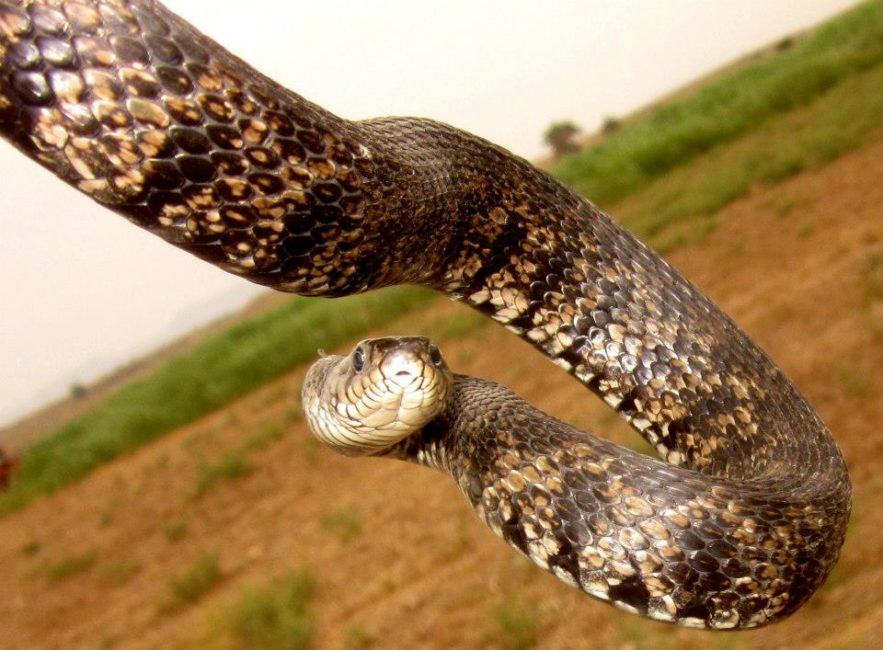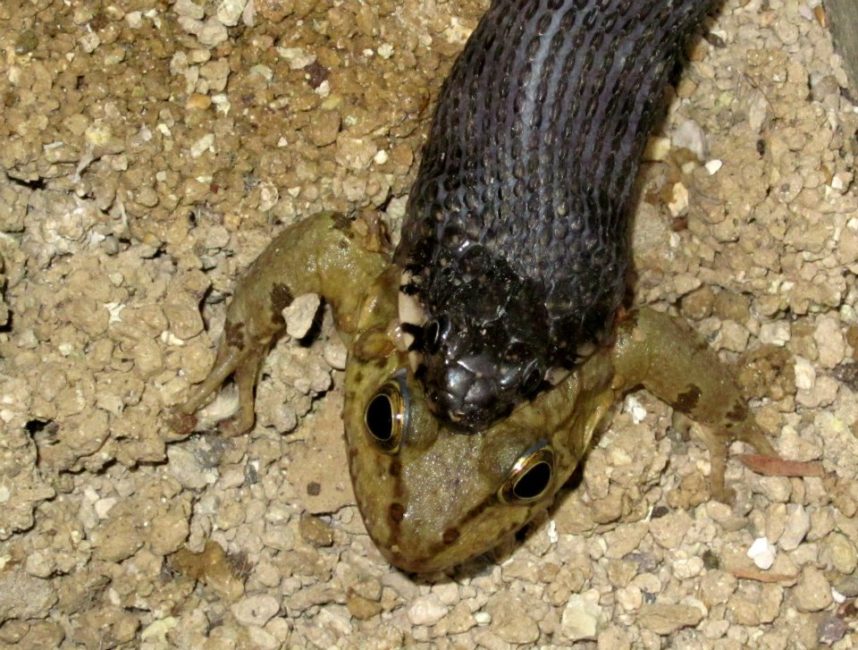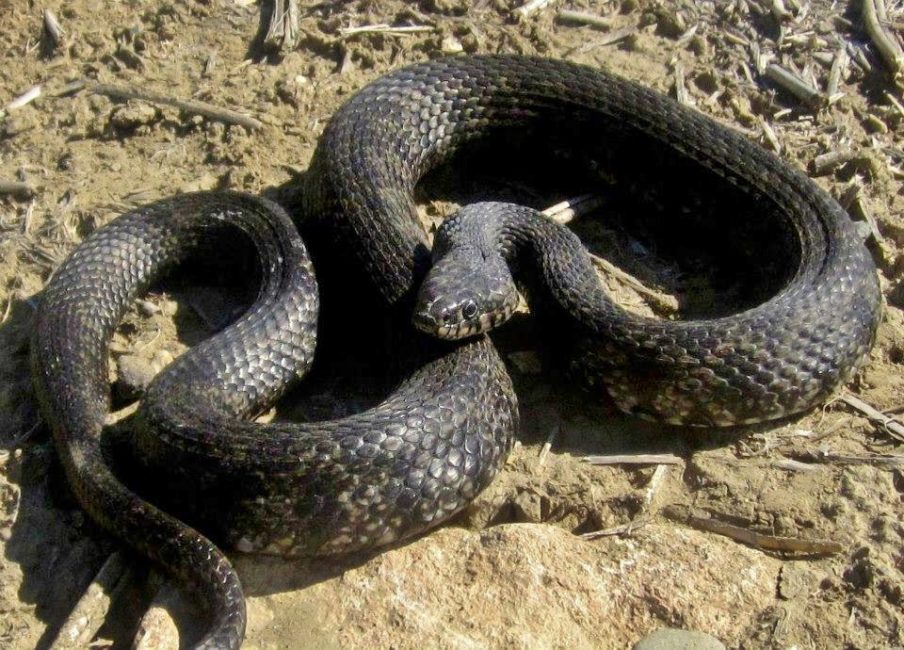In Cyprus we find twenty-two different species of reptiles. Eleven species of lizards, two species of sea turtles, one freshwater turtle and eight species of snakes. Snakes are found from sea level to the highest peaks of Troodos.
The Cypriot water snake (English Grass snake) with the scientific name Natrix natrix cypriaca (Linnaeus, 1758) is a subspecies of the Natrix natrix water snake, it is one of the 22 species of reptiles and one of the 8 species of snakes that we find in our place. It is an endemic subspecies of Cyprus and is endangered. It exists only in a few areas at the foot of the Troodos and at Lake Paralimni. It is found in freshwater, lakes, rivers and stagnant waters. He is an excellent swimmer and hides among aquatic vegetation and stones in the water. We also find it outside the water.
Its length reaches about one meter with the female being larger than the male and we find it in three different colors, gray with white-yellow, black, and black color in which pale white spots are distinguished. The black color is present only in the areas at the foot of the Troodos.
Fossils of the Cypriot water snake found in the area of Aetokremmos in Akrotiri indicate its presence in Cyprus over 10 to 12 thousand years ago. The fossils of the water snake were found together with other food remains of Neolithic people and this indicates that the water snake was a source of food for the first prehistoric inhabitants of Cyprus.
It is a completely harmless species for humans as it does not carry venom (ungulate) and feeds mainly on frogs, toads and fish that it catches in the water. It can swallow fish up to 15 points long. Note that, while almost all snakes swallow their prey starting from the head, the water snake when it catches a frog starts swallowing it from the legs, which is much more difficult.
It does not bite
Unlike other snakes, when caught, one does not bite at all to defend itself, nor does it even open its mouth. The water snake defends itself against predators by secreting a very foul-smelling liquid from special glands in the anus. It mates in the spring and lays the end of summer on land under stones and other objects up to 10 eggs that hatch in about two months. The eggs hatch with the temperature and humidity of the environment and the young after hatching are able to self-preserve.
The water snake was mentioned and has been described since 1758, when it lived in many areas of our island. In the years that followed, the water snake populations began to decline dramatically due to the drying up of swamps, the destruction of their natural habitats, the reckless spraying of waters with dangerous insecticides such as DDT, the uncontrolled housing development of all snakes by humans out of fear and ignorance (this is still happening today). Their population continued to decline until the 19th century when it was considered by experts that the species had disappeared from Cyprus forever. For forty whole years everyone believed that the Cypriot water snake had disappeared forever, until it was rediscovered in some areas by the Austrian herpetologist Hans-Jorg Wiedl, also known in Cyprus as Snake George, who is a permanent resident of Paphos. Hans is one of the authors of the book "Amphibians and Reptiles of Cyprus" and has worked very hard to protect and save the Cypriot water snake. Hans has also debunked the myth that existed in Cyprus that fine eggs give birth to live snakes, proving that they lay eggs.

Today in Cyprus the largest population of water snakes lives in Lake Paralimni but uncontrolled residential development on the shores of the lake, lack of protection and management of the area, toxic waste and rubbish thrown into the lake and uncontrolled access even by wheeled, has lead the fragile water snake population to the brink of extinction.

To protect the water snake, canals have been constructed in Lake Paralimni to conserve water during the dry summer months so that this rare species can find shelter and food. The Republic of Cyprus, in the framework of the implementation of its environmental policy and the fulfillment of its European obligations regarding the preservation and management of the natural environment, commissioned in September 2010 the elaboration of the Management Plan of the area "Lake Paralimni - CY3000008", in the Hellenic Center Habitats - Wetlands (EKBY). The Management Plan of the area "Lake Paralimni - CY3000008" was prepared in the framework of the project "Provision of Services for the preparation of a Management Plan for the area of Lake Paralimni", which was funded by national resources with the contracting authority of the Department of Environment Environment of Cyprus. The area of Lake Paralimni is a Site of Community Importance (SCI) and a Special Protection Zone (SPA) of the bird fauna, which is of particular ecological interest. From the reasoning and the philosophy of declaring the area as protected and the evaluation of its features and values, the following management objectives of the area emerge: the protection of the biological diversity of the area "Lake Paralimni - CY3000008" and the preservation of its wetland character.

Two of the specific purposes were to maintain the population of the Cypriot water snake Natrix natrix cypriaca at the levels of 2000 with the ultimate goal of increasing by 50% the population in the next decade and maintaining or increasing the populations of amphibians that are the main food source of the Cypriot water snake Natrix natrix cypriaca. Nevertheless, unfortunately, the atrocities in Lake Paralimni continue with the complete indifference of the competent authorities. The European Court of Justice in 2012 convicted Cyprus for insufficient protection of Lake Paralimni and the Cypriot water snake. But where do I tell you, where are you going, things are getting worse and worse with the incredible indifference of the competent authorities. My related article about Lake Paralimni here.

A few years ago a sufficient number of water snakes existed in the dam of Xyliatos but due to human factors they have now become extinct. Specifically, predatory fish were placed in the dam, such as sea bass and trout, which ate all the newborn water snakes that swam in the dam, the issuance of fishing licenses (incorrectly) in the specific dam and the failure to inform the fishermen about this protected species. I have seen water snakes swim near fishermen several times and they, out of fear, ignorance and even for fun, hit them with their rods and kill them. It is urgent to transfer to this dam, which was a natural habitat of the species, a native population of water snakes, to completely ban fishing and to fence the dam. Also, to clean it of garbage and tons of rubble and to fence Lake Paralimni and impose strict fines on anyone who violates these protected areas, only then will we be able to save this rare and unique species of Cyprus. And we have an obligation to do so. Of course knock on the door as much as you want. By creating laws and writing them on paper, nothing is done, projects are needed here and now.

Serious threat to water snakes
Apart from the human factor, natural enemies of water snakes in Cyprus are the prolonged drought resulting in lack of food, foxes, cats, birds of prey, mainly large herons, and some other species of snakes. A serious threat to water snakes is the American red freshwater crayfish Procambarus clarkii - Fresh water cray fish that was wrongly introduced to Cyprus in the 80's by the Department of Fisheries to enrich our dams for fishing purposes. This species, although an important food for many aquatic birds, is a great danger for the three amphibians (2 frogs, 1 toad) that we have in Cyprus, which in turn are the main food of water snakes. The crayfish feed on the eggs and tadpoles of frogs, the population of all three species of amphibians in lakes and dams has already been dramatically reduced so that in areas where water snakes live there is a lack of food, and this problem of dramatic reduction of Amphibians are everywhere as this species is found in almost all aquatic ecosystems of our place.
The Cyprus water snake is a priority species and (supposedly) is protected by strict protection by European Directive 92/43 / EC and strict protection by the Cyprus Law 153 (I) 2003. The water snake is also on the IUCN Red List, which includes all endangered species.

Source: POLITIS / George Constantinou
